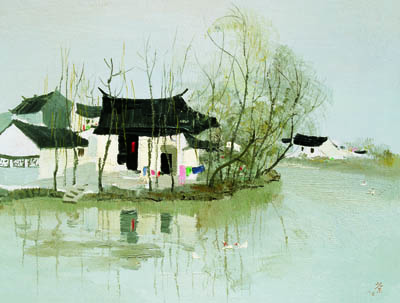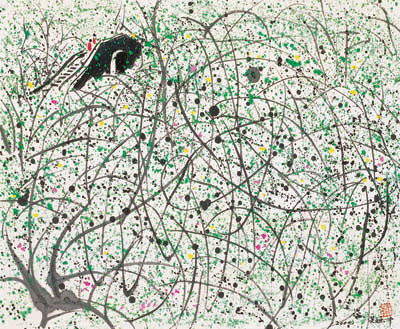HUA JUNWU: ALL HIS LIFE WITH CARTOONS & WU GUANZHONG: WORTHY PAINTING
| October 1, 2010 | Post In LEAP 5

Some exhibitions lie at once entirely within reason and completely beyond expectation. The National Art Museum’s special exhibitions memorializing the works of Hua Junwu (1915-2010) and Wu Guanzhong (1919-2010), which opened concurrently in July, serve together as a perfect example of this possibility. These two painters both hold important positions in the history of art in new China, and both passed away at the end of June. For Chinese people wary of calling a man great before the coming of the final judgment, this special double exhibition has a double meaning: on the one hand it is a rite of mourning, a consolation for the bereaved; on the other hand, it serves as a preliminary canonization, enacted by the nation’s ranking art museum for these departed saints. But the deceased have passed, and now, the more thought-provoking question lies in whether or not those still living can find a clue about the evolution of ideology or some other dramatic change in history emerging out of the unexpected coupling of these disparate bodies of work.
Hua Junwu, four years older than Wu Guanzhong, was one of China’s most famous cartoon artists. He was self-taught, and by his late youth his cartoons had already been linked to messages of national salvation and revolutionary faith. At the time, he was one of many progressive youths. In 1938 he was carried away to Yan’an, and in 1940 he went on to join the Communist Party. During the Anti-Japanese war and the War of Liberation, his cartoons concentrated even more on themes of politics and current affairs; they attacked the enemy, incited the masses, and propagandized the revolution. Meanwhile, though he shared the background of the same remarkable era, Wu was making a trek along his own path of artistic pursuit. Wu, whether before, during, or after his time studying painting at the National Academy of Art in Hangzhou, was an extremely industrious student. Even after graduating, he served as a teaching assistant at Chongqing University for many years—during which time he married—and was still unable to shake his conviction to go to Europe and to continue studying painting abroad. Between 1947 when he matriculated Ecole Nationale Supérieure des Beaux Arts in Paris and 1950 when he returned to a newly built China, he had the time to come to a thorough understanding of the Western tradition.


In his later years, Wu Guanzhong spoke frankly about the concern he had had over the “tough choice” of returning home. Wu’s fundamentally Modernist conception of painting made him unable to set foot on the path of soldier and peasant worship that was revolutionary art; at his core he still donned the academic cap of “formalism,” and in fact carried it with him to the end. At the same time, Wu also was aware of the fact that it would be very difficult to single-handedly change the artistic mainstream of his unfortunate moment. Therefore, not long after he returned home, he turned from thematic work in his paintings to landscape. At least in this way, the formalist style that he felt compelled to uphold could be guaranteed to remain safely in his works, without being subjected to certain excessive forms of external pressure. In stark contrast to the succession of setbacks that Wu met with upon returning home and throughout the remainder of his life, revolutionary participant Hua Junwu’s own trajectory as a result of the foundation of new China landed him in a position working for the People’s Daily Literary Department, and helped him to quickly rise to the level of leadership in the Chinese Artists Association, up to the point of being elected as its Vice Chairman in 1985.
Can it be true that things just change with the passage of time? In exhibition halls five and seven on the first floor of the National Art Museum of China where Hua Junwu’s cartoons are displayed, it is hard to tell that there was once such a close affiliation between this artist and the Artists Association. Whereas the works of Wu Guanzhong are hung prominently across the span of three exhibition halls on the fifth floor, Hua’s first-floor exhibition is not so easy to find, and its layout is slightly cramped. Aside from their frames, the three original series on display—“Incurable Disease,” “Life’s Sideshow” and “Zhu Bajie” (A cartoon of one of the principle characters in Wu Cheng’en’s Journey to the West)—are hung on the wall with no further explanation. In contrast, the fifth-floor exhibition is executed at a much higher standard. Though it is certainly not at the level of a full-dress art historical study, it is nevertheless much more meticulously done. Records and documentation accompany the artwork, and a few of Wu’s his most distinguished quotes are even projected onto the wall. The first floor has a few scattered visitors here and there, whereas the scene on the fifth floor is relatively lively—an audience of all ages constantly flows through, some even stopping to snap photos.
Those who care to take a closer look will discover that NAMOC applies a similar evaluation to the artistic maturation of each artist. Hua Junwu’s technique is presented in a light that reveals its concise and rich incorporation of various features of the cultural heritage; it is said to possess a distinctive Chinese style. Wu Guanzhong’s works are shown as furthering the twin discursive goals of a “nationalization of oil painting” and a “modernization of ink.” The curator is certainly determined in this regard, even if the audience does not necessarily share this same sense of purpose. The depth of the artists’ work does not come from the distinguishing nuances of their art; on the contrary, their works once again serve to prove the effectiveness of an appeal to viewers both cultured and not. Because of this quality in their work, out of extremely different approaches to their “politically correct” context both artists were able to arrive at a similar end. In an autobiography, Wu wrote of his astonishment over the fact that the artwork of a teacher J.M. Souverbie that he had idolized at school in Paris unexpectedly disappeared without a trace from a museum in France decades later; he subsequently lamented the mercilessness of history. There is no way to know if merciless history will at some point repeat itself and subject the work of these two artists to the same fate in their respective museum. But there is at least one thing that cannot be discounted—fake Wu Guanzhong paintings are already on the radar of discriminating art market connoisseurs, shedding light on another particular phenomenon so characteristic to our times. Sun Dongdong

